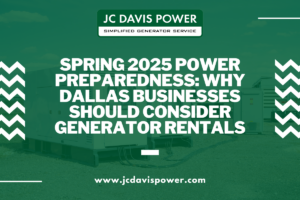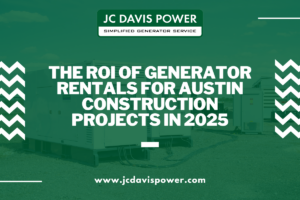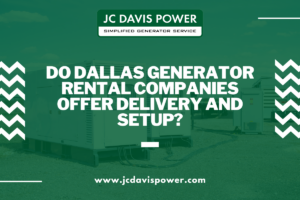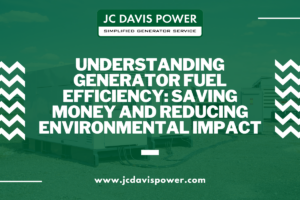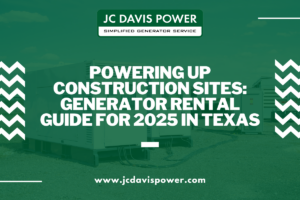Key Takeaways
- Check your power needs carefully to pick the right generator size
- Think about Texas weather and rules when renting equipment
- Look for quiet generators if you’re working in cities
- Check out new tech like smart generators and green energy options
- Put safety first when choosing and using generators
Construction sites need power to keep moving. For project managers in Texas, finding the right generator can help them decide if their project will be finished on time and on budget. As we look to 2025, construction power options are changing fast, with new tech and environmental concerns reshaping how we work.
Texas construction has its own challenges – hot summers and strict rules. Research shows that delays can stretch projects by 20% beyond their planned schedule, with power problems being a big cause. This guide will help you choose the right generator rental to keep your Texas construction site running smoothly in 2025.
Understanding Construction Site Power Needs in Texas
Assessing Power Requirements
Getting your power needs right is essential for any construction project. To figure out how much power you need, you should:
- List all equipment and how much power each needs
- Figure out when you’ll need the most power
- Account for extra power needed when motors start up
- Add 20% extra for unexpected power needs
Managing energy on a construction site isn’t just adding up numbers. You need a plan to share power effectively and avoid waste.
Equipment TypeAverage Power Draw (kW)Peak Power Draw (kW)Tower Crane80-100150-200Concrete Mixer5-1015-20Welding Machine5-1520-30Site Lighting2-5 per 1000 sq ftN/AOffice Trailer3-57-10
Texas-Specific Considerations
Texas presents unique challenges for construction power. When choosing generators in Texas, remember:
- Hot temperatures can affect how generators work
- You need good air flow to prevent carbon monoxide buildup
- Equipment needs protection from dust and debris
- Generators should be placed safely in flood-prone areas
- Coastal projects need hurricane readiness
Texas rules for construction power add another challenge. The Texas Commission on Environmental Quality (TCEQ) has strict emissions standards, especially in big cities like Austin, Dallas, and San Antonio. Following these rules is a must and will affect which generator you choose.
Types of Generators for Construction Sites
Portable vs. Stationary Generators
Your choice between movable and fixed generators depends on your project size and layout. Portable generators offer:
- Easy moving as your project changes
- Less downtime when you need to move power
- Lower setup costs
Stationary generators, while less flexible, give you:
- More power for big operations
- Better noise control
- Better protection from weather
- Automatic startup when needed
For most Texas projects, using both types often works best, giving you flexibility and reliable power.
Fuel Options: Diesel, Natural Gas, and Emerging Alternatives
The fuel debate is changing as costs rise and environmental concerns grow.
Fuel TypeGood PointsChallengesDieselLots of power, easy to findMore pollution, louderNatural GasCleaner, cheaper fuelLess power, needs pipelinesPropaneClean, easy to storeMore expensive, less powerBiodieselRenewable, fewer emissionsMay need engine changesSolar + BatteryNo emissions, quietDepends on weather, costs more upfront
Green power options are gaining ground in Texas. Recent Austin projects have combined solar panels with batteries, cutting generator runtime and fuel costs significantly.
Selecting the Right Generator for Your Project
Size and Capacity Considerations
Picking the right size generator is crucial. Too small means power shortages and possible equipment damage. Too big means wasting fuel and money, and can cause “wet stacking” that hurts efficiency.
When sizing your generator, consider:
- Total power needed (kW)
- Voltage and phase requirements
- How altitude and temperature affect performance
- Future expansion needs
Experts recommend running generators at 70-90% of their max capacity for best performance.
Noise Reduction and Urban Project Considerations
City construction sites face strict noise rules. Quiet generators are essential in Texas cities, where noise complaints can cause costly delays and fines.
Ways to reduce noise:
- Use generators with sound-blocking enclosures
- Place generators away from property lines
- Set up sound barriers or temporary walls
- Schedule noisy work during allowed hours
More cities now enforce strict decibel limits, especially for projects near homes or working unusual hours.
Cost-Effective Generator Rental Strategies
Rental vs. Purchase: Making the Right Choice
Deciding whether to rent or buy depends on project length, how often you’ll use it, and your budget. Renting often makes sense for shorter projects because:
- You can scale up or down as needed
- You get access to the newest technology
- You avoid maintenance and storage costs
- You can count it as an operating expense for tax purposes
For projects longer than 18 months, buying might save money. Still, many Texas construction firms prefer renting to stay flexible as technology changes.
Negotiating Rental Terms and Services
Getting a good rental deal requires understanding your project’s power needs and timeline. Key points to negotiate:
- Rental length and extension options
- Maintenance schedules
- Emergency response times
- Fuel delivery and management
- Training for your team
Make sure your rental agreement covers compensation for downtime and replacement guarantees. A comprehensive service package can greatly reduce the risk of costly power interruptions.
Future-Proofing Your Power Solutions for 2025 and Beyond
Emerging Technologies in Construction Site Power
The construction industry is seeing a power revolution. Tomorrow’s generators will feature:
- Internet connectivity for real-time monitoring and maintenance alerts
- Hybrid systems combining traditional generators with renewable sources
- Advanced energy storage for balancing loads
- Micro-grid capabilities for optimized power distribution
Remote monitoring systems are becoming standard, letting project managers track fuel, performance, and maintenance needs from anywhere, improving efficiency and reducing downtime.
Sustainability and Environmental Considerations
Being environmentally responsible is now a must in construction. Green power options are advancing quickly, driven by regulations and corporate responsibility.
Eco-friendly solutions include:
- Biodiesel and renewable diesel generators
- Hydrogen fuel cells
- Solar-powered site facilities
- Wind power where possible
- Energy recovery from construction waste
By 2025, we expect many Texas construction sites will use some form of renewable energy, marking a big shift toward greener building practices.
Safety and Emergency Preparedness
On-Site Safety Protocols for Generator Use
Safety comes first in construction power management. Your safety protocols must be strict and consistently followed.
Essential safety measures:
- Regular inspections and maintenance
- Proper grounding and electrical connections
- Clear signs and restricted access areas
- Spill containment and fire suppression equipment
- Protective equipment for operators
- Proper ventilation to prevent carbon monoxide poisoning
Training is vital. Everyone working with or around generators should learn safety procedures, including emergency shutdowns and electrical first aid.
Backup Power Strategies
Emergency backup plans are crucial for keeping critical operations running. A good backup plan should include:
- Redundant generators for essential functions
- Quick-connect ports for adding units fast
- Automatic transfer switches for seamless power switching
- Priority load shedding plans to manage limited backup capacity
Backup planning goes beyond equipment. It includes clear communication protocols, assigned emergency roles, and regular drills to ensure readiness.
Conclusion
As we approach 2025, construction power solutions in Texas are evolving rapidly. From smart generators to sustainable energy, options for powering construction sites are more diverse and efficient than ever. By carefully assessing your project’s specific needs, staying informed about new technologies, and prioritizing safety and sustainability, you can keep your construction site powered and productive no matter what challenges arise.
Remember, the right generator rental strategy isn’t just about keeping equipment running—it’s about improving project efficiency, meeting environmental standards, and staying competitive. As you plan your next Texas construction project, use this guide to make smart decisions that will power your success well into the future.
